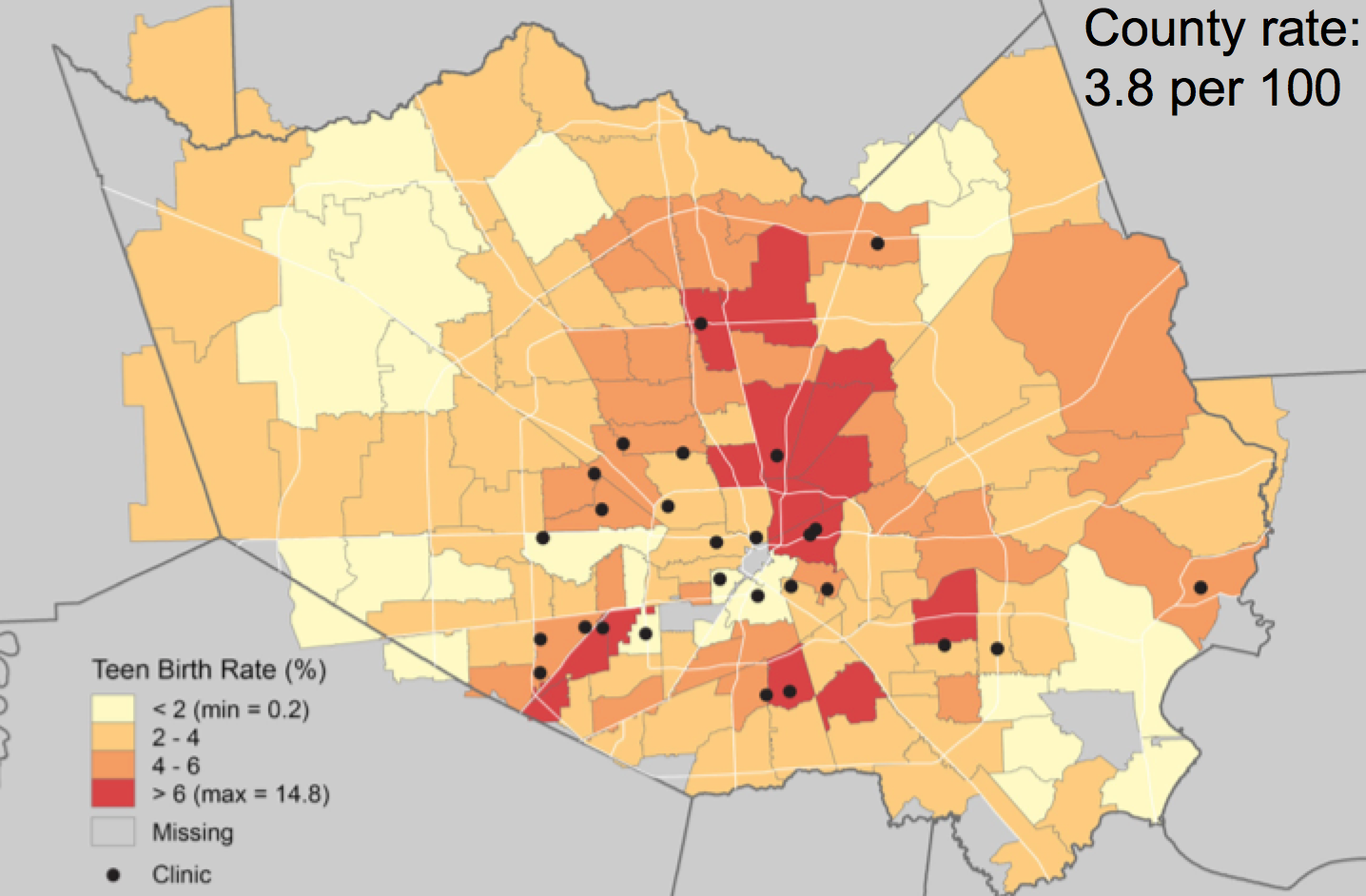Though the teenage birth rate has been declining nationally in recent years, Texas has the fourth-highest rate of teen motherhood in the country, tied with New Mexico, with 34.6 births per 1,000 teenage girls in 2015.
In a state that also leads the nation in its maternal death rate, teen pregnancies can mean a host of negative and lasting consequences for mothers, including lower educational attainment and poverty.
Researchers have identified a range of risk factors tied to teen pregnancy, but a new analysis seeks to isolate and examine the connection between federally-funded clinics and teenage birth rates in Houston. Researchers found that for two groups in particular — black teenagers and white teenagers who live in economically depressed zip codes — there was a link, but overall the relationship between clinic distance and teen births pointed to a more complicated relationship.
Looking at Houston health centers and clinics that receive federal funding and target underserved areas and teenage birth rates by zip code, Megan Wisniewski, a post-baccalaureate fellow with the Kinder Institute for Urban Research, and Heather O'Connell, a post-doctoral fellow also with the Institute, mapped how teen birth rates changed as distances from clinics grew.
Though teenage birth rates have been declining in the state, disparities between races persist. "That's true nationally and it's also true for our data in Harris County," said O'Connell. "It's important to think about how race may be structuring proximity to clinics."
The clinics included in the study offer both family planning and contraceptive services, and because of their affordability, they were thought to represent the lowest barriers to accessing those services. The researchers acknowledged that teenagers may be getting contraception and other services elsewhere, including charity clinics which don't have public records.
Despite the low financial barriers present, the researchers found that proximity to those clinics did not always translate into lower birth rates. In fact, for the total population, birth rates by zip code were not correlated with clinic locations. But that relationship changed for specific populations.
So, for white teenagers who lived in zip codes with high levels of poverty, birth rates increased as distance from a clinic grew. And for black teenagers, regardless of the poverty level of the zip code they lived in, rates also increased as distances did.
"Zip codes that are one mile further away from the nearest clinic will have black teenage birth rates that are one percentage-point higher than zip codes that are one mile closer to a clinic," explained O'Connell. "The relationship between clinic distance and white teenage birth rates is more complex," she added, so "zip codes with high poverty rates - say 35 percent - see an increase in white teenage birth rates of just over half a percentage-point for every mile increase in clinic distance."
"However, that relationship is flat - meaning that there is no increase in white teen birth rates in relation to clinic distance - at medium poverty levels (15 percent), and the relationship is negative for low poverty zip codes (5 percent)."
But for Hispanic teenagers, there seemed to be little correlation between clinic proximity and birth rates.
"The relationship between teen birth rates and clinic proximity is more complicated within the Hispanic community in Houston," said Wisniewski, pointing to other factors that might serve as barriers to access.
"Geographic barriers are not the only reason why clinics are not reflected in the spatial patterning of Hispanic birthrates," said O'Connell. "There are other factors."
"Certain social determinants, such as high unemployment, low education, and low income, have been associated with higher teen birth rates," according to the Centers for Disease Control and Prevention. "Interventions that address socioeconomic conditions like these can play a critical role in addressing disparities observed in U.S. teen birth rates." Daughters of teenage mothers are more likely to become teenage mothers themselves. Girls in foster care are also more at-risk for becoming teenage mothers.
Education also plays a role. A recent study from the activist group Texas Freedom Network found that some 83 percent of Texas school districts offer abstinence-only or no sex education.
In Houston, though clinic distance wasn't the only thing that impacted teenage birth rates, the researchers said, it was still a significant factor. Looking at areas with high birth rates, O' Connell said the research pointed to the scarcity of clinics outside the city core where there were also some of the highest teenage birth rates.



